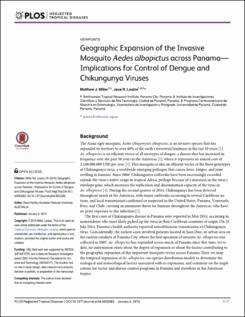Geographic Expansion of the Invasive Mosquito Aedes albopictus across Panama— Implications for Control of Dengue and Chikungunya Viruses
Fecha
2015-01-08Autor
Miller, Matthew J.
Loaiza, Jose R.
Metadatos
Mostrar el registro completo del ítemResumen
The Asian tiger mosquito, Aedes (Stegomyia) albopictus, is an invasive species that has expanded its territory to over 40% of the earth’s terrestrial landmass in the last 30 years [1]. Ae. albopictus is an efficient vector of all serotypes of dengue, a disease that has increased in frequency over the past 30 years in the Americas [2], where it represents an annual cost of 2,100,000,000 USD per year [3]. This mosquito is also an efficient vector of the three genotypes of Chikungunya virus, a worldwide emerging pathogen that causes fever, fatigue, and joint swelling in humans. Since 2006, Chikungunya outbreaks have been increasingly recorded outside the virus’s native range in tropical Africa, perhaps because of a mutation in the virus’s envelope gene, which increases the replication and dissemination capacity of the virus in Ae. albopictus [4]. During the second quarter of 2014, Chikungunya has been detected throughout much of the Americas, with major outbreaks occurring in several Caribbean nations, and local transmission confirmed or suspected in the United States, Panama, Venezuela, Peru, and Chile, creating an imminent threat for humans throughout the Americas, who have no prior exposure to this infection [5]. The first cases of Chikungunya disease in Panama were reported in May 2014, occurring in nonresidents who most likely picked up the virus in their Caribbean countries of origin. On 23 July 2014, Panama’s health authority reported autochthonous transmission of Chikungunya virus. Coincidentally, the earliest cases involved patients located in Juan Diaz, an urban area on the eastern outskirts of Panama City, where the first specimen of invasive Ae. albopictus was collected in 2002. Ae. albopictus has expanded across much of Panama since that time, yet to date, no information exists about the degree of expansion or about the factors contributing to the geographic expansion of this important mosquito vector across Panama. Here, we map the temporal expansion of Ae. albopictus, use species distribution models to determine the ecological and nonecological factors associated with its expansion, and comment on the implications for vector and disease control programs in Panama and elsewhere in the American tropics.

